Abstract
Tungsten is an essential metal for the manufacture of special alloys, which is in constant demand due to the development of the industry. The recovery of scheelite from undeveloped tungsten ore in South Korea was investigated to improve the flotation performance for high grade and recovery of concentrate. To investigate the interaction between the flotation reagents and the minerals, the adsorption experiments of oleic acid as a collector on Ca-bearing minerals, such as scheelite, calcite, and fluorite were carried out. This reaction was confirmed chemical adsorption by analysis of zeta potential and FTIR analysis. The batch test was performed using a raw ore to enhance the grade and recovery of the scheelite concentrate. It was obtained at the optimal conditions for high WO3 grade and recovery of scheelite concentrate by using a simple process. In particular, the sodium carbonate used as a pH modifier was investigated to increase scheelite flotation performance by supporting the selective depression of Ca-bearing gangue minerals. Furthermore, a locked cycle test (LCT) was carried out based on batch test results for the design of a continuous pilot plant.
1. Introduction
Tungsten has been one of the important metals, which is widely used in various industries such as alloys, electron, chemical engineering, etc. [1,2,3,4,5,6,7]. Not only does it have the highest melting point among metals, but it also shows particularly high physical properties including moduli of compression and elasticity, thermal creep resistance and electrical conductivity [1,3,4,8]. Due to its significant economic importance and high supply risks, it has been classified as a strategic metal. According to a recent report, more than 80% of tungsten is produced in China, though a large amount of tungsten has been produced in Korea [1,6,9]. The Sangdong mine in South Korea was the powerhouse of the economy in the 1940s, contributing more than 50% of the export revenue in Korea [10]. This mine deposit acted as one of the largest tungsten resources across the globe. Furthermore, it had been the leading global tungsten producer for more than 40 years before it ceased to produce tungsten in 1992, not because of resource depletion [9]. Therefore, this indicates the current amount of undeveloped ore is expected to remain large. Additionally, the interest in the development of tungsten has been gradually increasing and the flotation characteristics of tungsten ore from the Sangdong mine are required for the re-development plan.
There are various types of tungsten minerals. Among them, scheelite (CaWO4) is considered as an economically important mineral [2,4,5,6,7,9,11,12,13,14,15,16,17]. To be specific, scheelite is easily ground to fine particles during crushing and grinding processes due to its brittleness [1,18,19]. Generally, scheelite is partially composed of particles as fine as these particles, which is different from other types of minerals. This characteristic can be one of the reasons why many researchers have conducted researches about froth flotation for the recovery of scheelite from tungsten ore [1,19,20]. Froth flotation is an extensively used separation technique in the minerals industry that is based on differences in the surface properties of particles [1,5,7,11].
A fatty acid collector is extensively used in scheelite flotation from the raw ore during the process of separation [2,8,13,15,21]. Scheelite is often associated with other Ca-bearing salt-type minerals such as calcite and fluorite, which has similar characteristics [5,6,7,22,23]. Their dissolved mineral species in the pulp might be some reactions such as hydrolysis, precipitation and adsorption which can affect the interaction between reagents and minerals [5,24]. Therefore, it is desirable to select suitable modifiers and depressants for selective separation which is available through the flotation method [5,6,7,8,12,16,21,24]. In particular, the studies on various kinds of flotation reagents have been carried out, and most of them have focused on the development of new collectors and depressants [8,11,14,15,21,25]. Nevertheless, this is still mostly basic research based on the reactivity of pure minerals and reagents, and conventional reagents are used in the field. Recently it has been carried out that sodium carbonate, which is known as a pH modifier, has a positive effect on the flotation of scheelite [25,26,27,28]. Based on this research, it is very important to improve and investigate the mechanism by applying it to the real complex ore system.
This research mainly aimed to investigate the flotation characteristics for scheelite recovery from undeveloped tungsten ore in South Korea. Particularly, it focused on improving the selective separation performance of scheelite during the flotation process by using suitable flotation reagents. The effect of Na2CO3 on WO3 grade and recovery of scheelite concentrate have been investigated to improve flotation performance. Additionally, this mechanism was conducted, not a only batch test, but also a locked cycle test using raw ore in Sangdong mine.
2. Materials and Methods
2.1. Materials and Reagents
Pure minerals were used in adsorption experiments and analysis. They are as follows: scheelite, calcite, fluorite from China. It was analyzed through inductively coupled plasma atomic emission spectrometer (ICP-AES, Optima-5300DV, Perkin Elmer, Waltham, MA, USA). The raw ore sample used in this study was obtained from the Sangdong mine in Korea (Almonty Korea Tungsten Corporation). They were initially crushed using a crusher (Cone crusher, The Hankook Powder Machine Engineering, Gyeonggi-do, Korea) and then pulverized in a mill (Rod mill, The Hankook Powder Machine Engineering, Gyeonggi-do, Korea). For the flotation the particle size of 80% passing 74 μm was used. Reagents (potassium amyl xanthate (KAX, C5H11KOS2), methyl isobutyl carbinol (MIBC, C5H14O), sodium carbonate (Na2CO3) sodium hydroxide (NaOH), sodium sulfide (Na2S), calcium oxide (CaO), sodium silicate (Na2SiO3), oleic acid (C18H34O2), Lankropol K-8300 (disodium oleamido MIPA-sulfosuccinate, Akzo Nobel Surface Chemistry LLC, Chicago, IL, USA)) used were supplied by Sigma Aldrich (Saint Louis, MO, USA) and were of technical and analytical grade in this research.
2.2. Experimental Methods and Analysis
A total of 1 kg of real, raw ore sample in the Sangdong mine was subjected to the flotation experiments carried out in a flotation cell of a lab-scale Denver Sub-A flotation machine with 35% solids pulp density and 1500 rpm stirring. Batch type flotation experiments were conducted in accordance with the flow sheet shown in Figure 1. Sulfides flotation is a process to remove sulfides mineral, such as molybdenum (molybdenite, MoS2) in ores before the scheelite flotation process, because they adversely affect the grade and recovery of concentrate in scheelite flotation. In this process, 150 g/t of KAX and 50 g/t of MIBC were used as a collector and frother, respectively. Scheelite rougher flotation was carried out using the remaining pulp with suspended sulfides, such as pyrite and molybdenite. Rougher flotation is a process to remove gangue minerals such as silicate minerals, calcite, and fluorite and increase the recovery of the scheelite. Moreover, 1–5 kg/t of Na2CO3, NaOH, Na2S, and CaO were used as pH modifiers, 4–7 kg/t of Na2SiO3 as a depressant, 200–350 g/t of oleic acid as a collector and 75 g/t of K-8300 as a frother. Cleaner flotation is a process to float scheelite only for producing a high grade concentrate as possible without the addition of any reagent. Furthermore, a locked cycle test was carried out based on these results to calculate material balance to provide a design of a continuous pilot plant.
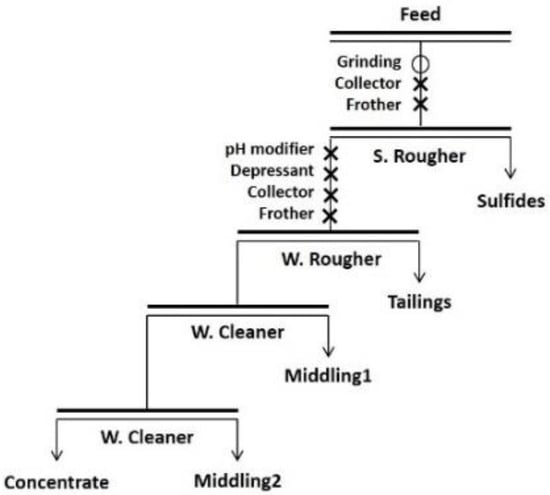
Figure 1.
Flowsheet of the batch type scheelite flotation from tungsten ore.
The zeta potential measurements were carried out using a zeta potential analyzer (ELS-Z Zeta Potential analyzer, Otsuka Electronics, Osaka, Japan). For measurement, the samples were ground to particles less than 5 μm using an agate mortar. The mineral suspensions with 0.01% of the samples were stirred. The pH value of suspension was adjusted to a required pH value using 0.1 N HCl and 0.1 N NaOH [29].
The FTIR analysis was carried out using a FTIR-ATR spectrometer (Nicolet 6700 FTIR Spectrometer with Attenuated Total Reflectance, Thermo Scientific, Waltham, MA, USA). For measurement, the samples were ground to particles less than 5 μm using an agate mortar. The system was equipped with a diamond ATR crystal, and then mineral particles were pressed and fastened towards the ATR crystal to collect background spectra first. All spectra were collected at room temperature [30].
The mineralogy and chemical composition of the samples were obtained using X-ray diffraction spectrometer (XRD, X’Pert MPD, Philips, Amsterdam, The Netherlands), X-ray fluorescence spectrometer (XRF, MXF-2400, Shimadzu, Kyoto, Japan) and scanning electron microscopy-energy dispersive spectrometry (SEM-EDS, Tabletop Microscope TM3000, Hitachi, Tokyo, Japan). The WO3 content of samples was analyzed by inductively coupled plasma atomic emission spectrometer (ICP-AES, 5300DV, Perkin Elmer)
After flotation, the floated and un-floated products were collected, filtered, dried in ovens for 24 h at 90 °C, weighed and analyzed. The flotation performance is expressed by Grade (G) that is the content of a valuable component in the product, recovery (R) of concentrate and enrichment ratio (ER). The recovery is the qualitative and quantitative parameter of the product in which C and c are the weight and grade of concentrate, F and f are the weight and grade of the feed, respectively. Recovery is the percentage of the total mineral or metal contained in the ore, which is recovered in the concentrate. The recovery of the concentrate is given by this Equation [18,31]:
The enrichment ratio is the ratio of the grade of the concentrate (c) to the grade of the feed (f) and is given by this Equation [32]:
3. Results and Discussion
3.1. Adsorption Mechanism between Mineral Surfaces and Flotation Reagents
The adsorption mechanism of oleic acid with Ca-bearing minerals was investigated through zeta potential and FTIR analysis. The surface charge of mineral particles is changed by pulp pH value and affects the adsorption of the collector on mineral surfaces [33,34]. To investigate the adsorption mechanism of the reagents on the mineral surface, the effects of zeta potential are shown in Figure 2. The zeta potentials of Ca-bearing minerals in tungsten ore such as scheelite, calcite and fluorite were measured at pH 2–12. It has been confirmed the scheelite has a negative electric charge in all pH areas, and that the point of zero charge (PZC) of the calcite is 9–10 and the fluorite is 4–5, respectively. Oleic acid was used as a collector to react with all minerals and to measure the zeta potential again to confirm that the zeta potential values in all minerals were significantly negatively shifted. As a result, the reaction between these Ca-bearing minerals and oleic acid was found to be chemical adsorption, not physical adsorption with different pH and surface charges of minerals [34,35].
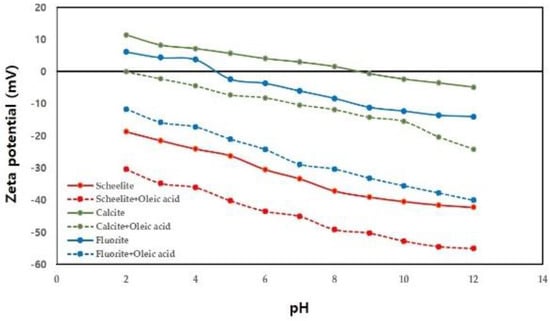
Figure 2.
Zeta potentials of scheelite, calcite and fluorite in the absence and presence of oleic acid as a collector.
In order to further determination, the adsorption mechanism of flotation reagents on Ca-bearing mineral surfaces, the FTIR spectra of scheelite, calcite and fluorite before and after treating with flotation reagents were measured. Figure 3 shows FTIR spectra of scheelite, calcite, and fluorite before and after flotation reagent treatment at pH 11. In the addition of the oleic acid as collector, several new peaks are observed in the spectra of (a) scheelite, (b) calcite, and (c) fluorite. The new peaks at 2852 cm−1 and 2922 cm−1 are due to the –CH3 and –CH2 stretching bands in the oleic acid, indicating the chemical adsorption of oleic acid on each Ca-mineral surface [3,17]. This chemical adsorption consists of monolayer adsorption, allowing only one reagent to react to each available site on the mineral surface for adsorption. Sodium carbonate as a selective depressant of Ca-bearing minerals was reacted before the oleic acid to confirm the adsorption mechanism between flotation reagents and mineral surfaces. The results showed that oleic acid did not react to mineral surfaces after reaction with sodium carbonate. It is confirmed that the surface of Ca-bearing minerals occurred monolayer adsorption with flotation reagents by chemical adsorption.

Figure 3.
FTIR spectra of (a) scheelite, (b) calcite, and (c) fluorite in the absence and presence of flotation reagents (OA: Oleic Acid, SC: Sodium Carbonate).
3.2. Characterization of the Tungsten Ore from Sangdong Mine in South Korea
Figure 4 shows X-ray powder diffraction patterns of run-of-mine tungsten ore from the Sangdong mine in South Korea. According to these results, tungsten mineral in the ore consists of scheelite, and major gangue minerals consist of quartz (SiO2), hedenbergite (Ca(Fe,Mg)(SiO3)2), biotite (K(Mg,Fe)3(AlSi3O10)(F,OH)2), magnesiohornblende (Ca2(Mg,Fe)5(Si,Al)8O22(OH)2), calcite (CaCO3), and fluorite (CaF2)). It was confirmed that the chemical composition of scheelite ore was SiO2 57.20 wt.% and Al2O3 13.61 wt.%, Fe2O3 10.48 wt.%, CaO 6.79 wt.% and small amounts of WO3 0.41 wt.% by XRF and ICP analysis (Table 1.).
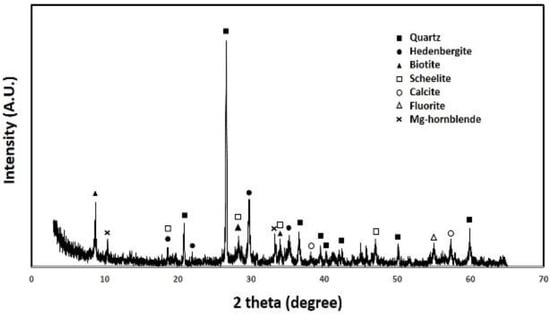
Figure 4.
X-ray powder diffraction patterns of the run-of-mine tungsten ore from the Sangdong mine in South Korea.

Table 1.
Chemical composition of the tungsten ore from Sangdong mine in South Korea.
3.3. Effect of Flotation Reagent on the Selective Depression of Ca-Bearing Minerals in Real Ore System
According to the investigation results, flotation experiments using a real ore have been conducted in the Denver Sub-A type flotation cell. The pH control during flotation is deemed as critical because the mineral surface characteristics in the pulp and the reactivity with the reagent vary as the pH of the pulp changes [1,19]. Corresponding to the preliminary experiment result, the pH of the pulp was adjusted to 11 and the experiments were conducted using NaOH, Na2S, CaO, and Na2CO3 as pH modifiers. For a depressant and a collector of scheelite flotation, Na2SiO3 and oleic acid were selected due to the preliminary experimental results and they are widely used in many conventional processes [5,23,24,34,36,37,38]. Figures S1–S3 show the results of the experiment with the variable type of depressant, collector, and frother in this study.
Figure 5a shows the WO3 grade and recovery of the concentrate according to the type of pH modifier with optimal dosage, respectively (Na2CO3; 4 kg/t, NaOH; 2 kg/t, CaO; 3 kg/t, and Na2S; 2 kg/t at Na2SiO3; 4 kg/t, oleic acid; 300 g/t, K-8300; 75 g/t). Na2CO3 was used as a pH modifier; it was found that the performance was maximized with the WO3 grade of 70.2% and the recovery of 83.15% and small amounts of Mo 0.002%, Fe 0.2%, and Sn 5.2 mg/kg. This result confirmed that the tendency was similar to that of other research, and the mechanism for this was determined as follows [26]. In comparison to the case that NaOH used as a general pH modifier, CO32− in Na2CO3 seemed to influence the selective separation of scheelite. Na2CO3 is ionized in the pulp, and CO32− reacts with Ca2+ on the surface of Ca-based minerals and precipitates as CaCO3 like surface carbonation. In this process, the Ca-bearing gangue minerals such as calcite and fluorite, which have relatively high Ca surface site density, have been employed to precipitate on the surface by reacting earlier than scheelite with low Ca surface site density (Fluorite: 11.1–12.9 μmol/m2, Calcite: 8.24 μmol/m2 and Scheelite: 5.06–6.58 μmol/m2) [24,26,39]. To support this, there is a Ca–O (Ca–F) bond length. It is known that the shorter the bond length, the larger the bond energy. Relatively short bond lengths of calcite and fluorite reacted with Na2CO3, which is likely to be depressed before scheelite due to the enhanced reactivity due to the larger bond energy (Calcite: 2.36 Å, Fluorite: 2.37 Å and Scheelite: 2.44–2.48 Å) [15,24,26,40]. Furthermore, Na2+ in Na2CO3 reduces the probability that Ca2+ activates quartz and hereby silicates [26,41]. To sum up, after the addition of Na2CO3 to the pulp, based on kinetics, fluorite is the first mineral to be depressed, then calcite, silicates, and finally scheelite, if Na2CO3 overdosed. When the oleic acid is added after this reaction, scheelite reacted with less CO32− among Ca-bearing minerals, is adsorbed with oleic acid as a collector. It is confirmed that the available adsorption site on the scheelite surface is limited due to the reaction between the scheelite surface and the flotation reagent is chemical adsorption. As a result, the surface of the scheelite becomes hydrophobic, adheres to the bubbles, and floats in the pulp. Figure 6 shows the selective depressing mechanism of Ca-bearing gangue minerals using Na2CO3. Figure 5b shows the WO3 grade and recovery of the concentrate according to the dosage of Na2CO3. The more pH modifier was added, the more the grade and recovery of the concentrate were showed until 4 kg/t of Na2CO3. This is because the concentration of CO32− in the pulp increased and CO32− precipitated as a form of CaCO3 onto the surface of scheelite as well as calcite and fluorite [26].
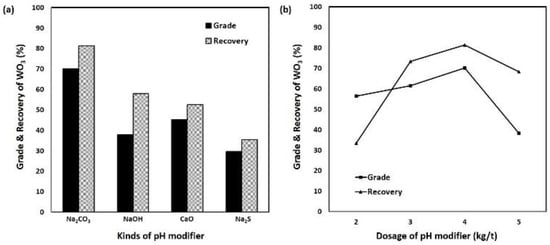
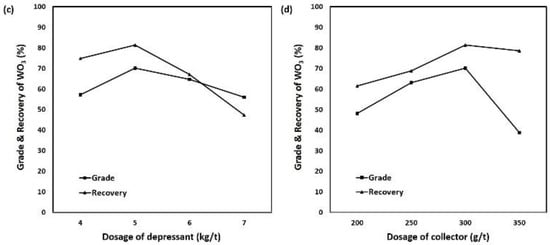
Figure 5.
Effects of operation parameters on the scheelite flotation (a) kinds of pH modifier, (b) dosage of sodium carbonate as pH modifier, (c) dosage of sodium silicate as depressant, (d) dosage of oleic acid as collector, respectively.
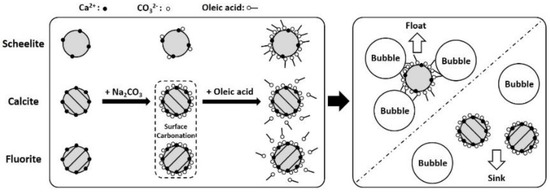
Figure 6.
Schematic diagram of the selective depressing mechanism using sodium carbonate on the Ca-bearing mineral surface for recovery of scheelite.
Na2SiO3 is widely used as a reagent to depress gangue minerals that consists of silicate minerals [11,14]. Figure 5c shows the WO3 grade and recovery of the concentrate according to the addition amount of Na2SiO3 used as a depressant. The recovery decreases as the reagent addition amount increases, and the grade increases continuously, but decreases at more than 5 kg/t of Na2SiO3. When the depressant is added in the pulp, silicate minerals are strongly hydrophilized and depressed, but when excess is added, HSiO3- reacts with the scheelite to form (HSiO3)2Ca salt to make it hydrophilic [16,19,36,37]. Therefore, it is explained that scheelite did not react with oleic acid used as a collector, is depressed, and remains in the flotation cell without floating.
Oleic acid is one of the fatty acids with aliphatic tails and is known to have excellent performance in collecting the scheelite in froth flotation [1,34]. Figure 5d shows the WO3 grade and recovery of the concentrate with respect to the additional amount when oleic acid was used as a collector. As the addition amount of the collector increased, the grade gradually increased but the recovery decreased at more than 300 g/t of oleic acid. This is because the hydrophobicity of the particle surface and the possibility of adhesion to bubbles for flotation is increased as the amount of the collector added increases [19,38]. When oleic acid is added in an excess amount, it is considered that not only scheelite but also other gangue minerals are collected, which leads to a decrease in the WO3 grade of concentrate.
Figure 7 shows the X-ray diffraction patterns of raw ore sample and each process product in Figure 1. In the case of tailings, silicate minerals, such as quartz, feldspar, and mica, are contained in large quantities. In Figure 7b, sulfides are the products obtained by using KAX, a typical collector of sulfide minerals [1,27]. Therefore, it can be confirmed that most of the suspended minerals are pyrite (FeS2) and molybdenite (MoS2). In Figure 7c, tailings were found to be quite similar in composition. Most of these products contain quartz, a silicate mineral, some magnesiohornblende and biotite. In Figure 7a., the concentrate consists mostly of scheelite, and some of the same Ca-minerals calcite and fluorite exist. Based on the XRD analysis results in Figure 7, SEM-EDS analysis was carried out to determine the more accurate characteristics of the final concentrate, and it was confirmed that most of the composition was Ca, W and O in the scheelite (CaWO4) and very small impurities such as Mo and Si existed (Figure 8).

Figure 7.
X-ray diffraction patterns and image of flotation products (a) concentrate, (b) sulfides, and (c) tailings, respectively.
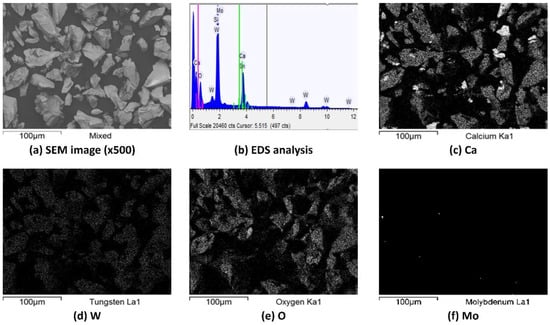
Figure 8.
(a) SEM image, (b) energy dispersive spectrometry (EDS) spectrum, and element mapping images for (c) Ca, (d) W, (e) O, and (f) Mo of the final scheelite concentrate, respectively.
Additionally, to investigate the separation mechanism of the sodium carbonate-sodium silicate-oleic acid system, the grade and recovery of concentrates were measured by the change of the added reagent order. Adding Na2SiO3 followed by Na2CO3, the grade and recovery of concentrate were 0.45%, 0.02%, and it is explained that scheelite was not separated from the tungsten ore at all. This can be attributed to the fact that the reactivity of the mineral with the collector was influenced by the reaction order between the reagent and the surface of the minerals (Figure S4) [26]. Na2CO3 prevents the depressing effect caused by adsorption of Na2SiO3 on the surface of scheelite. The addition of Na2CO3 before the addition of Na2SiO3 leads to the formation of CaCO3 precipitates on the surface through the process of surface carbonation reaction of Ca-bearing minerals such as calcite and fluorite before scheelite [25,26,42]. It activated the depression caused by Na2SiO3 in gangue minerals [3,25,43]. Conversely, when Na2SiO3 is added first, Na2SiO3 depressed all minerals and scheelite was not been able to be separated from the raw ore.
3.4. Locked Cycle Test (LCT)
A total of six cycles of LCT was carried out to calculate material balance based on the batch test results (70.2 WO3%, 83.15%). The flotation circuit including one sulfide rougher, two sulfide scavenger, one scheelite rougher, two scheelite scavenger and four scheelite cleaner. The flotation flowsheet is presented in Figure 9, and the results are listed in Figure 10, and Table 2. The WO3 grade and recovery in scheelite concentrate attained to 71.2% and 83.37% (average value of 4–6 cycles). The enrichment ratio (ER) is more than 170 with a high recovery. The concentrate grade and yield of the final 3 cycles in the 6 cycle test are almost constant (Grade; ±0.1%, Recovery; ±0.1% and Yield; ±1.4%). These results show that the performance of LCT with the optimal condition was good mass conservation and good stability. This suggests that the developed flotation process effectively enriched the tungsten minerals in the raw ore of Sangdong mine. LCT results can be used to provide a baseline for the design and operation of a continuous pilot plant.
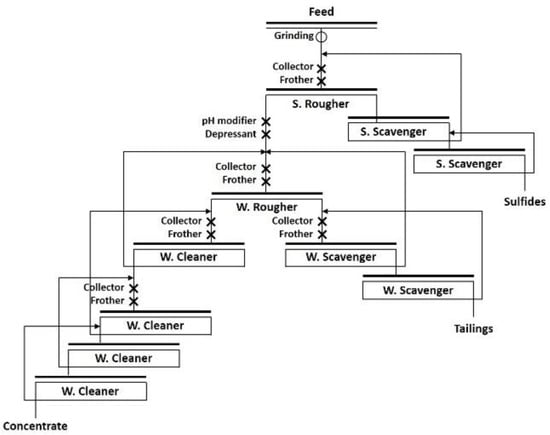
Figure 9.
Flowsheet of the locked cycle test for scheelite flotation from tungsten ore.
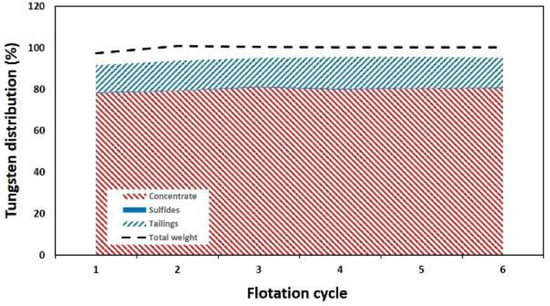
Figure 10.
Mass and tungsten (W) output distribution of each cycle product by locked cycle test, respectively.

Table 2.
Concentrate grade, enrichment ratio (ER), recovery and yield of each cycle product of locked cycle test.
4. Conclusions
In this study, flotation experiments were carried out to investigate the flotation mechanism and improve the scheelite flotation performance of undeveloped tungsten ore from the Sangdong mine in South Korea. The tungsten ore used in this study contains scheelite minerals with a WO3 grade of 0.41%. Moreover, it was confirmed that calcite, fluorite, and other silicate minerals are present as major gangue minerals that can retard selective separation of scheelite. To reveal the adsorption mechanism of the reagents on the mineral surface, basic adsorption experiments of reagents and pure minerals were conducted. This reaction was confirmed chemical adsorption by analysis of zeta potential and FTIR analysis. Then, kinds of modifiers and dosages, and the addition order of flotation reagent experiments were conducted to determine the factors affecting the grade and recovery of scheelite concentrate. Corresponding to the experiment results with various types of pH modifiers, it was confirmed that Na2CO3 performed not only pH control, but also the depressing of Ca-bearing gangue minerals based on kinetics. After the addition of Na2CO3 to the pulp, it is ionized in the pulp and CO32− reacts with Ca2+ on the surface of Ca-based minerals and precipitates, as CaCO3 like surface carbonation. The fluorite is the first mineral to be depressed, then calcite, silicates, and finally scheelite. Furthermore, the flotation performance was greatly different according to the added order of the reagent due to the reaction order between the flotation reagent and mineral surface. Based on the locked cycle test, the optimal conditions for recovering high grade and recovery (71.2 WO3%, 81.37%) with good mass conservation and stability were obtained.
Supplementary Materials
The following are available online at https://www.mdpi.com/2075-163X/10/11/971/s1, Figure S1: Effect of types of depressant on scheelite concentrate grade and recovery of WO3, Figure S2: Effect of types of collector on scheelite concentrate grade and recovery of WO3, Figure S3: Effect of types of frother on scheelite concentrate grade and recovery of WO3, Figure S4: Effect of reaction order on the scheelite flotation (a) pH modifier-depressant-collector-frother and (b) depressant-pH modifier-collector-frother.
Author Contributions
Conceptualization, S.K., and H.-S.J.; methodology, S.K., and S.-H.B.; formal analysis, S.K., and Y.H.; investigation, S.K., Y.H., and S.-H.B.; writing—original draft preparation, S.K.; writing—review and editing, S.K., Y.H., and H.-S.J. All authors have read and agreed to the published version of the manuscript.
Funding
This research was supported by the Basic Research Project (20-3212-1) of the Korea Institute of Geoscience and Mineral Resources (KIGAM) funded by the Ministry of Science, ICT and Future Planning of Korea and the Korea Institute of Energy Technology Evaluation and Planning (KETEP) and the Korean Ministry of Trade, Industry& Energy (MOTIE), Republic of Korea (No. 20172510102220).
Conflicts of Interest
The authors declare no conflict of interest.
References
- Yang, X. Beneficiation studies of tungsten ores—A review. Miner. Eng. 2018, 125, 111–119. [Google Scholar] [CrossRef]
- Yan, W.; Liu, C.; Ai, G.; Feng, Q.; Zhang, W. Flotation separation of scheelite from calcite using mixed collectors. Int. J. Miner. Process. 2017, 169, 106–110. [Google Scholar] [CrossRef]
- Bo, F.; Xianping, L.; Jinqing, W.; Pengcheng, W. The flotation separation of scheelite from calcite using acidified sodium silicate as depressant. Miner. Eng. 2015, 80, 45–49. [Google Scholar] [CrossRef]
- Ahmad Hamid, S.; Alfonso, P.; Oliva, J.; Anticoi, H.; Guasch, E.; Hoffmann Sampaio, C.; Garcia-Vallès, M.; Escobet, T. Modeling the Liberation of Comminuted Scheelite Using Mineralogical Properties. Minerals 2019, 9, 536. [Google Scholar] [CrossRef]
- Zhu, W.; Dong, L.; Jiao, F.; Qin, W.; Wei, Q. Use of Sodium Hexametaphosphate and Citric Acid Mixture as Depressant in the Flotation Separation of Scheelite from Calcite. Minerals 2019, 9, 560. [Google Scholar] [CrossRef]
- Kang, J.; Hu, Y.; Sun, W.; Gao, Z.; Liu, R. Utilization of Sodium Hexametaphosphate for Separating Scheelite from Calcite and Fluorite Using an Anionic–Nonionic Collector. Minerals 2019, 9, 705. [Google Scholar] [CrossRef]
- Wei, Z.; Fu, J.; Han, H.; Sun, W.; Yue, T.; Wang, L.; Sun, L. A Highly Selective Reagent Scheme for Scheelite Flotation: Polyaspartic Acid and Pb–BHA Complexes. Minerals 2020, 10, 561. [Google Scholar] [CrossRef]
- Abdalla, M.A.M.; Peng, H.; Younus, H.A.; Wu, D.; Abusin, L.; Shao, H. Effect of synthesized mustard soap on the scheelite surface during flotation. Colloids Surf. Physicochem. Eng. Aspects 2018, 548, 108–116. [Google Scholar] [CrossRef]
- Choi, W.; Park, C.; Song, Y.; Park, C.; Kim, H.; Lee, C. Sequential Scheelite Mineralization of Quartz–Scheelite Veins at the Sangdong W-Deposit: Microtextural and Geochemical Approach. Minerals 2020, 10, 678. [Google Scholar] [CrossRef]
- Klepper, M.R. The Sangdong tungsten deposit, southern Korea. Econ. Geol. 1947, 42, 465–477. [Google Scholar] [CrossRef]
- Deng, R.; Yang, X.; Hu, Y.; Ku, J.; Zuo, W.; Ma, Y. Effect of Fe(II) as assistant depressant on flotation separation of scheelite from calcite. Miner. Eng. 2018, 118, 133–140. [Google Scholar] [CrossRef]
- Dong, L.; Jiao, F.; Qin, W.; Zhu, H.; Jia, W. Selective depressive effect of sodium fluorosilicate on calcite during scheelite flotation. Miner. Eng. 2019, 131, 262–271. [Google Scholar] [CrossRef]
- Feng, B.; Guo, W.; Peng, J.; Zhang, W. Separation of scheelite and calcite using calcium lignosulphonate as depressant. Sep. Purif. Technol. 2018, 199, 346–350. [Google Scholar] [CrossRef]
- Wei, Z.; Hu, Y.; Han, H.; Sun, W.; Wang, R.; Wang, J. Selective flotation of scheelite from calcite using Al-Na2SiO3 polymer as depressant and Pb-BHA complexes as collector. Miner. Eng. 2018, 120, 29–34. [Google Scholar] [CrossRef]
- Gao, Y.; Gao, Z.; Sun, W.; Yin, Z.; Wang, J.; Hu, Y. Adsorption of a novel reagent scheme on scheelite and calcite causing an effective flotation separation. J. Colloid Interface Sci. 2018, 512, 39–46. [Google Scholar] [CrossRef]
- Han, H.; Hu, Y.; Sun, W.; Li, X.; Cao, C.; Liu, R.; Yue, T.; Meng, X.; Guo, Y.; Wang, J.; et al. Fatty acid flotation versus BHA flotation of tungsten minerals and their performance in flotation practice. Int. J. Miner. Process. 2017, 159, 22–29. [Google Scholar] [CrossRef]
- Meng, Q.-Y.; Feng, Q.-M.; Ou, L.-M. Effect of temperature on floatability and adsorption behavior of fine wolframite with sodium oleate. J. Cent. South Univ. 2018, 25, 1582–1589. [Google Scholar] [CrossRef]
- Baek, S.; Jeon, H. Application of Jig Separation for Pre-Concentration of Low-Grade Scheelite Ore. Mater. Trans. 2018, 59, 494–498. [Google Scholar] [CrossRef]
- Kupka, N.; Rudolph, M. Froth flotation of scheelite–A review. Int. J. Min. Sci. Technol. 2018, 28, 373–384. [Google Scholar] [CrossRef]
- Zhao, C.; Sun, C.; Yin, W.; Luo, B. An investigation of the mechanism of using iron chelate as a collector during scheelite flotation. Miner. Eng. 2019, 131, 146–153. [Google Scholar] [CrossRef]
- Deng, L.; Zhao, G.; Zhong, H.; Wang, S.; Liu, G. Investigation on the selectivity of N-((hydroxyamino)-alkyl) alkylamide surfactants for scheelite/calcite flotation separation. J. Ind. Eng. Chem. 2016, 33, 131–141. [Google Scholar] [CrossRef]
- Zhang, Y.-Z.; Gu, G.-H.; Wu, X.-B.; Zhao, K.-I. Selective depression behavior of guar gum on talc-type scheelite flotation. Int. J. Min. Metall. Mater. 2017, 24, 857–862. [Google Scholar] [CrossRef]
- Wei, Z.; Hu, Y.; Han, H.; Sun, W.; Wang, R.; Sun, W.; Wang, J.; Gao, Z.; Wang, L.; Zhang, C.; et al. Selective Separation of Scheelite from Calcite by Self-Assembly of H2SiO3 Polymer Using Al3+ in Pb-BHA Flotation. Minerals 2019, 9, 43. [Google Scholar] [CrossRef]
- Kupka, N.; Babel, B.; Rudolph, M. The Potential Role of Colloidal Silica as a Depressant in Scheelite Flotation. Minerals 2020, 10, 144. [Google Scholar] [CrossRef]
- Filippov, L.O.; Foucaud, Y.; Filippova, I.V.; Badawi, M. New reagent formulations for selective flotation of scheelite from a skarn ore with complex calcium minerals gangue. Miner. Eng. 2018, 123, 85–94. [Google Scholar] [CrossRef]
- Kupka, N.; Rudolph, M. Role of sodium carbonate in scheelite flotation–A multi-faceted reagent. Miner. Eng. 2018, 129, 120–128. [Google Scholar] [CrossRef]
- Amarante, M.M. Scheelite Flotation from Tarouca Mine Ores AU–Martins, J.I. Miner. Process. Extr. Metall. Rev. 2013, 34, 367–386. [Google Scholar]
- Liu, C.; Feng, Q.; Zhang, G.; Chen, W.; Chen, Y. Effect of depressants in the selective flotation of scheelite and calcite using oxidized paraffin soap as collector. Int. J. Miner. Process. 2016, 157, 210–215. [Google Scholar] [CrossRef]
- Han, Y.; Han, S.; Kim, B.; Yang, J.; Choi, Y.; Kim, K.; You, K.-S.; Kim, H. Flotation separation of quartz from apatite and surface forces in bubble-particle interactions: Role of pH and cationic amine collector contents. J. Ind. Eng. Chem. 2019, 70, 107–115. [Google Scholar] [CrossRef]
- Kim, S.; Park, S.; Han, S.; Han, Y.; Park, J. Silanol-rich ordered mesoporous silica modified thiol group for enhanced recovery performance of Au(III) in acidic leachate solution. Chem. Eng. J. 2018, 351, 1027–1037. [Google Scholar] [CrossRef]
- Han, Y.; Yang, J.; Jung, M.; Han, S.; Kim, S.; Jeon, H. Controlling the pore size and connectivity of alumina-particle-stabilized foams using sodium dodecyl sulfate: Role of surfactant concentration. Langmuir 2020, 36, 10331–10340. [Google Scholar] [CrossRef] [PubMed]
- Vinnett, L.; da Silva, G.R.; Marion, C.; Carrasco, C.; Waters, K.E. The use of enrichment ratios to support kinetic studies in flotation. Miner. Eng. 2019, 144, 106054. [Google Scholar] [CrossRef]
- Li, X.; Zhang, Q.; Hou, B.; Ye, J.; Mao, S.; Li, X. Flotation separation of quartz from collophane using an amine collector and its adsorption mechanisms. Powder Technol. 2017, 318, 224–229. [Google Scholar] [CrossRef]
- Dong, L.; Jiao, F.; Qin, W.; Zhu, H.; Jia, W. Activation effect of lead ions on scheelite flotation: Adsorption mechanism, AFM imaging and adsorption model. Sep. Purif. Technol. 2019, 209, 955–963. [Google Scholar] [CrossRef]
- Jia, W.-H.; Qin, W.-Q.; Chen, C.; Zhu, H.-I.; Jiao, F. Collecting performance of vegetable oils in scheelite flotation and differential analysis. J. Cent. South Univ. 2019, 26, 787–795. [Google Scholar] [CrossRef]
- Gao, Y.; Gao, Z.; Sun, W.; Hu, Y. Selective flotation of scheelite from calcite: A novel reagent scheme. Int. J. Miner. Process. 2016, 154, 10–15. [Google Scholar] [CrossRef]
- Marinakis, K.I.; Shergold, H.L. Influence of sodium silicate addition on the adsorption of oleic acid by fluorite, calcite and barite. Int. J. Miner. Process. 1985, 14, 177–193. [Google Scholar] [CrossRef]
- Gao, Z.; Hu, Y.; Sun, W.; Drelich, J.W. Surface-Charge Anisotropy of Scheelite Crystals. Langmuir 2016, 32, 6282–6288. [Google Scholar] [CrossRef]
- Lu, Y.; Drelich, J.; Miller, J.D. Oleate Adsorption at an Apatite Surface Studied by Ex-Situ FTIR Internal Reflection Spectroscopy. J. Colloid Interface Sci. 1998, 202, 462–476. [Google Scholar] [CrossRef]
- Huggins, M.L. Atomic Radii. IV. Dependence of Interatomic Distance on Bond Energy1. J. Am. Chem. Soc. 1953, 75, 4126–4133. [Google Scholar] [CrossRef]
- Cooke, S.R.B. Minerals Beneficiation–The Flotation of Quartz Using Calcium Ion as ivator. Trans. Am. Inst. Min. Metall. Pet. Eng. 1950, 184, 306. [Google Scholar]
- Miller, J.D.; Hiskey, J.B. Electrokinetic behavior of fluorite as influenced by surface carbonation. J. Colloid Interface Sci. 1972, 41, 567–573. [Google Scholar] [CrossRef]
- Gao, Z.; Bai, D.; Sun, W.; Cao, X.; Hu, Y. Selective flotation of scheelite from calcite and fluorite using a collector mixture. Miner. Eng. 2015, 72, 23–26. [Google Scholar] [CrossRef]
Publisher’s Note: MDPI stays neutral with regard to jurisdictional claims in published maps and institutional affiliations. |
© 2020 by the authors. Licensee MDPI, Basel, Switzerland. This article is an open access article distributed under the terms and conditions of the Creative Commons Attribution (CC BY) license (http://creativecommons.org/licenses/by/4.0/).